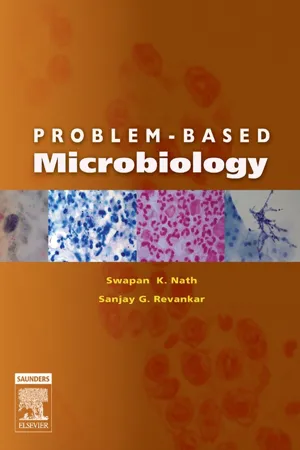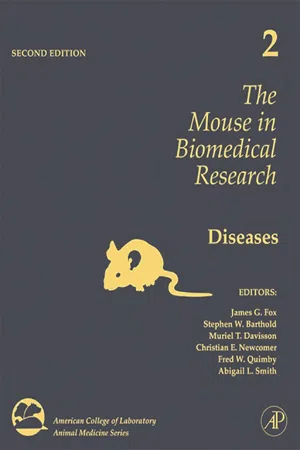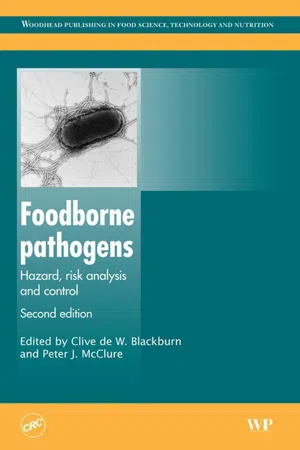Biological Sciences
Gram Positive Cocci
Gram-positive cocci are a type of bacteria that have a spherical shape and retain a purple stain in the Gram staining process. They are characterized by a thick peptidoglycan cell wall and lack an outer membrane. Examples of gram-positive cocci include Staphylococcus and Streptococcus species, which can cause a range of infections in humans.
Written by Perlego with AI-assistance
Related key terms
Related key terms
1 of 4
Related key terms
1 of 3
7 Key excerpts on "Gram Positive Cocci"
- eBook - ePub
Microbiology and Molecular Diagnosis in Pathology
A Comprehensive Review for Board Preparation, Certification and Clinical Practice
- Audrey Wanger, Violeta Chavez, Richard Huang, Amer Wahed, Amitava Dasgupta, Jeffrey K. Actor(Authors)
- 2017(Publication Date)
- Elsevier(Publisher)
Sanginosis anginosis Cocci in chains Tiny, green Beta − + Bovis grp., for example, Streptococcus gallolyticus Cocci in chains Tiny, green Gamma − V No growth Enterococcus spp. Cocci in pairs/chains Small, gray, smooth Gamma + + GrowthS , sensitive; R , resistant; −, negative; +, positive.Vancomycin Resistant Gram-Positive Cocci
Leuconostoc and Pediococcus cause opportunistic infections, including bacteremia, wound and CNS infections, endocarditis, and peritonitis [21 ,22] . They appear as α hemolytic colony on BAP and can resemble streptococci. Biochemical tests are used to differentiate these organisms from other Gram-positive cocci. PYR tests are negative and the ability to produce leucine aminopeptidase and hydrolyze esculin (ESC) can differentiate the two. Other Gram-positive cocci are summarized in Table 6.3 .Table 6.3 Other Gram-positive cocciOrganism Gram stain morphology Colony Hemolysis Vancomycin Catalase Pyrrolidonyl arylamidase Leucine amino-peptidase Esculin Abiotrophia Gram-negative, coccobacilli Alpha Small, gray-white S − + w+ − Granulicatella Gram-negative, coccobacilli Alpha Tiny, gray S − + w+ − Leuconostoc Gram-positive coccobacilli Alpha Small, smooth gray R − − − V Pediococcus Gram-positive, cocci Alpha Small, gray R − − + + S , sensitive; R , resistant; w , weakly; −, negative; +, positive.Gram-Positive Bacilli
Gram-positive bacilli appear as rod shaped organisms and may have spores if they are depleted of nutrients on some media. Gram-positive bacilli will grow on blood agar plates and some that produce pigmentation such as Rhodococcus may appear as irregular rods. Some genera will stain positive with a weak acid fast stain such as Nocardia and appear as filaments in the Gram stain.Gram Positive, Endospore-Forming Bacilli
Most aerobic endospore-forming bacilli are ubiquitous, environmental organisms and do not normally cause disease. Endospores produced are highly resistant to extreme heat, desiccation, and radiation and can therefore survive in any environment including hospitals, food products, and in farms. - eBook - ePub
- Swapan K. Nath, Sanjay G. Revankar(Authors)
- 2005(Publication Date)
- Saunders(Publisher)
B ) Streptococcus pyogenes Clusters Divide in three planes (Fig. B-1C) Staphylococcus aureus Bacilli (Rods) Short rods Rounded ends (Fig. B-1D) Pseudomonas aeruginosa Coccobacilli Short, rounded Francisella tularensis Fusiform Tapered ends Fusobacterium necrophorum Curved Rods Vibrios Hook or comma shaped (Fig. B-1E) Vibrio cholerae Filamentous forms Beaded Nocardia asteroides , Mycobacterium tuberculosisFIGURE B-1 Bacterial morphologies. A , Diplococci (Streptococcus pneumoniae ). B , Cocci in chains (Streptococcus pyogenes ). C , Cocci in clusters (Staphylococcus aureus ). D , Rods (Pseudomonas aeruginosa ) E , Curved rods-vibrios (Vibrio cholerae ). F , Spiral-shaped bacilli (Treponema pallidum ).Gram staining is used to differentiate bacteria based on their cell-wall characteristics. The process is based on the ability of acetone or alcohol to extract an iodine-crystal violet (a basic purple dye) complex through the cell wall (see Appendix D for detailed methodology). The washed bacteria are examined after counterstaining with safranin (red dye), and the bacteria are either Gram positive or Gram negative. Gram-positive bacteria have a single membrane surrounded by a thick cell wall that retains crystal violet (and thus stain purple ). Gram-negative bacteria have an inner and an outer membrane with a thin cell envelope between the membranes. Gram-negative bacteria cannot retain crystal violet, but they can retain safranin counterstain (and thus stain red ). In older cultures of Gram-positive bacteria, some of the bacteria may appear Gram-negative or Gram-variable (and appear to be a mixture of purple and pink) because dye-retaining properties are lost over time.Bacterial Ultrastructures
Bacteria do not have a clearly defined nucleus; rather most have a single chromosome attached to an invagination of the cytoplasmic membrane, which plays a key role in segregation of the two daughter chromosomes following chromosomal replication. Some bacteria have circular DNA molecules, called plasmids , which replicate autonomously from the chromosome and usually contain antibiotic-resistance and/or virulence genes . Plasmids are often exchanged between different bacteria via conjugation, transformation, or even transduction. Ribosomes are found in the cytoplasm or associated with the cell membrane. Storage granules contain reserve polymers (e.g., glycogen) synthesized in the presence of an excess carbon source for utilization later but do not increase the osmotic pressure of the cell. Polymerized metaphosphate [(PO3 )]n , also called “metachromatic granules ” (e.g., Corynebacterium diphtheriae - eBook - ePub
The Mouse in Biomedical Research
Diseases
- (Author)
- 2006(Publication Date)
- Academic Press(Publisher)
Chapter 16Aerobic Gram-Positive Organisms
Cynthia Besch-Williford and Craig L. FranklinI. IntroductionII. StaphylococcusA. Bacterial Properties B. Cultivation C. Strains D. Clinical Manifestations E. Epizootiology F. Diagnosis G. Treatment and ControlIII. StreptococcusA. Bacterial Properties B. Cultivation C. Strains D. Clinical Manifestations E. Epizootiology F. Diagnosis G. Control and PreventionIV. CorynebacteriumV. Summary ReferencesA. Corynebacterium bovis1 Bacterial Properties 2 Cultivation 3 Strains 4 Clinical Manifestations 5 Epizootiology 6 Diagnosis 7 Treatment and ControlB. Corynebacterium kutscheri1 Bacterial Properties 2 Cultivation 3 Strains 4 Clinical Manifestations 5 Epizootiology 6 Diagnosis 7 Treatment and ControlI. INTRODUCTION
Gram-positive bacterial infections in mice are among the most common causes of sporadic infections in research colonies, but the lack of recent reports of disease under-represents disease prevalence in contemporary research facilities. Clinical expression of infection is typical of pyogenic disease, with clinical signs that range from localized conjunctivitis and dermatitis to fulminate septicemia. Treatment of infections is often instituted to salvage valuable mutant mice until studies are concluded or until mice can be rederived. Many grampositive bacteria that cause disease in mice are commensals on the skin and mucous membranes of other laboratory animals and people. Housing and handling procedures must be implemented to minimize transmission by contact with colonized mice or contaminated fomites, including materials used in experimentation. In this chapter, we discuss gram-positive micrococci and corynebacteria as pathogens of concern to researchers who use mice.II. STAPHYLOCOCCUS
Staphylococci are hardy gram-positive, coccoid bacteria that commonly colonize the skin, mammary glands, mucous membranes, and gastrointestinal tract of man and animals, including laboratory mice ( Bannerman 2003 ). Surveys of staphylococcal carriage revealed cutaneous colonization of about 90% of healthy people and approximately 75% of conventional laboratory mice (Nagase et al. 2002). The predominant isolate from man was Staphylococcus epider-midis, with S. warneri as a distant second. In contrast, Staphylococcus xylosus and S. sciuri were most often recovered from mice. In both man and mouse, fewer than 10% carried Staphylococcus aureus . While the distribution of staphylococcal species is quite different between man and mouse, one similarity is that the predominant staphylococcal skin commensals do not produce coagulase. Coagulase-negative isolates were once thought to be nonpathogenic. When coagulase-negative staphylococci were recovered from wounds, especially cutaneous wounds, it was difficult to determine if these bacteria were bystanders or pathogens. Isolation of coagulase-negative staphylococci from biofilms on indwelling medical devices and from pyogenic infections in immunosuppressed mice and people suggest these staphylococci are pathogenic, but have a different virulence factor repertoire than those of the well-studied coagulase-positive staphylococci such as S. aureus ( Bannerman 2003 - eBook - ePub
Scott-Brown's Otorhinolaryngology and Head and Neck Surgery
Volume 1: Basic Sciences, Endocrine Surgery, Rhinology
- John Watkinson, Ray Clarke, John C Watkinson, Ray W Clarke(Authors)
- 2018(Publication Date)
- CRC Press(Publisher)
Another more rapid diagnostic technique that has recently come into routine use in many laboratories is matrix-assisted laser desorption/ionization and time of flight analysis, or MALDI-TOF, which uses mass spectrometry to measure species-specific profiles of biomolecules, such as peptides and sugars, and larger organic molecules following laser ionization of a sample absorbed onto a specific test matrix. This is currently only possible from a pure culture, but may become available as a technique usable directly on clinical samples.In the future, whole genome sequencing may come to supersede conventional culture techniques entirely, as it is able to not only identify bacterial species directly from clinical samples, but is also able to deliver a full profile of antimicrobial resistance. This has the benefit of identifying genes responsible for resistance (genotype) as opposed to current conventional susceptibility testing that detects phenotypic resistance.Classification of bacterial organisms
The Gram stain continues to be one of the most frequently used and simple tests performed in clinical microbiology laboratory practice, and gram staining of pus and tissue samples can provide vital early information on possible causative organisms in an infective process.Figure 19.3provides an overview of gram positive organisms and gram negative organisms (Figure 19.5) commonly encountered in clinical practice.Figure 19.3 Overview of medically important Gram positive organisms.Gram positive organisms
Staphylococci
Staphylococci are Gram positive, catalase positive organisms that on microscopy after Gram staining lie together in clusters, reflecting the fact that they are able to divide in more than one geometrical plane. Staphylococcal species form part of the normal skin flora.There are several species of coagulase negative staphylococci. Most are skin commensals with low pathogenic potential, although they are able to cause indolent infections of intravascular devices and implants. An exception to this is Staphylococcus lugdunensis , which although coagulase negative, produces infections which present clinically much like infections with Staphylococcus aureus .S. aureus - eBook - ePub
Microbial Food Safety
A Food Systems Approach
- Charlene Wolf-Hall, William Nganje(Authors)
- 2017(Publication Date)
- CAB International(Publisher)
6 Gram-Positive BacteriaKey Questions• Which Gram-positive bacteria are of most concern for microbial food safety?• What are the mechanisms by which these Gram-positive bacteria cause illness?• What are the hazards these Gram-positive bacteria present to consumers?• What controls are available to prevent foodborne illness due to these Gram-positive bacteria?The Difference Between Gram-Positive and Gram-Negative Bacteria
Hans Christian Gram was the Danish scientist who, in 1884, published a method for a staining technique to help better see bacteria in tissue samples under the microscope. An unanticipated result of this technique was a way to differentiate two major groups of bacteria based on their cell wall compositions.Bacterial cell membranes that contain thick layers of peptidoglycan are able to retain the crystal violet stain used in the method, resulting in purple- or violet-stained cells that are described as Gram positive. Bacteria that contain less peptidoglycan in their cell membranes are unable to retain the crystal violet stain after the destaining step of the procedure, and as a result of counter-staining with safranin dye appear red or pink, and are described as Gram negative. As with all microbiological testing methods, there are limitations and some bacterial species may produce Gram-variable results, indicating an ability to stain with either reaction result and not provide a clear distinctive result.Gram staining is a preliminary test used on bacterial cultures to give clues to the identity of the species. The Gram reaction is a first clue, and then other clues like the microscopic cell morphology or shape and placement can provide other clues. The remainder of this chapter will focus on those bacterial pathogens of most concern in foods that fall under the category of Gram positive, and Chapter 7 - eBook - ePub
Foodborne Pathogens
Hazards, Risk Analysis and Control
- Clive de W Blackburn, Peter J McClure(Authors)
- 2009(Publication Date)
- Woodhead Publishing(Publisher)
22Staphylococcus aureus and other pathogenic Gram-positive cocci
M. Adams University of Surrey, UKAbstract
The role of Gram-positive cocci as agents of foodborne illness is described along with methods for their control. The chapter focuses primarily on staphylococcal food poisoning caused by Staphylococcus aureus , but the enterococci and pathogenic streptococci that can be transmitted by food are also discussed.Key words Staphylococcus aureus enterococci Streptococcus22.1 Introduction
This chapter discusses a number of bacteria which share a Gram-positive coccoid morphology and an association with foodborne illness. It focuses primarily on Staphylococcus aureus since it is the most significant cause of foodborne illness among these organisms.Other organisms discussed here are the enterococci which are commonly found in the gastrointestinal tract of humans and animals and in a variety of foods. These are associated with a variety of infections, and have been implicated in outbreaks of foodborne illness in the past. Some of the evidence relating to this is discussed here. Finally, some other pathogenic streptococci which are occasionally spread by food are considered.22.2 Staphylococcus aureus and other enterotoxigenic staphylococci
22.2.1 The organism and its characteristics
In recent years Staph. aureus has attracted much attention and notoriety as a cause of human infections, and it was in this role that it was first described by Ogston in 1882. He coined the name staphylococcus to describe the microscopic appearance of pyogenic bacteria which resembled bunches of grapes. The first recognised description of its association with foodborne illness came very shortly afterwards when Vaughan identified coccoid bacteria as responsible for illness caused by cheese and, later, ice cream in Michigan (Vaughan, 1884 ; Anon., 1886 ). He also isolated and crystallised a putative toxin which he named tyrotoxicon. Subsequent reports in the early 20th century associated the organism with illness from meat products in Belgium and mastitic milk in the Philippines, and in 1930 Dack, investigating an outbreak caused by a cream filled cake, showed that staphylococcal food poisoning was caused by a filterable enterotoxin (Dack et al - eBook - ePub
- Vincent A. Fischetti, Richard P. Novick, Joseph J. Ferretti, Daniel A. Portnoy, Mirian Braunstein, Julian I. Rood, Vincent A. Fischetti, Richard P. Novick, Joseph J. Ferretti, Daniel A. Portnoy, Mirian Braunstein, Julian I. Rood(Authors)
- 2019(Publication Date)
- ASM Press(Publisher)
Fig. 5 ).Figure 4: Visualization of Gram-positive bacterial capsules. (A) Cationic gold nanoparticles (lysine-coated 15-nm gold nanoparticles) label the thick capsule of Streptococcus pneumoniae after fixation with 1% formaldehyde at low pH (stars). (B) Cryo-FESEM at close-to-nature conditions reveals the thick capsule layer of S. pneumoniae marked with white stars. The thickness is comparable to the labeled capsule in (A); samples were nitrogen-slush-frozen, freeze-fractured at –105°C, freeze-etched at –105°C for 30 sec, and sputter-coated with gold/palladium. (C) For ultrathin sections, capsules can be preserved with the lysine-ruthenium-red osmium embedding protocol (see reference 52 ). Following embedding in LRWhite resin, Streptococcus suis is surrounded by a dense capsule layer (white stars).Figure 5: Good preservation of streptococcal capsules under in vivo conditions. (A) Streptococcal capsules (Streptococcus pyogenes administered intravenously) are well preserved (black stars) in spleen under in vivo conditions in the mouse model even after fixation with glutaraldehyde and formaldehyde, dehydration with acetone, and embedding in epoxy resin and ultrathin sectioning. (B) Enlargement of another bacterium depicting nicely preserved capsule (black stars). Most likely, proteins in the blood have covered and preserved the capsule and prevented loss of capsule during aldehyde fixation.EXTRACELLULAR VESICLES OF GRAM-POSITIVE BACTERIA
The extracellular vesicles formed by Gram-negative bacteria have been known of since the 1960s, whereas reports about extracellular vesicles from Gram-positive bacteria first appeared in the early 1990s (65 , 66 ). The entire process of forming extracellular vesicles is nowadays referred to as vesiculogenesis (67 ). One reason for the lack of studies of extracellular vesicles of Gram-positive bacteria might be that it was believed that such vesicles simply could not be generated, due to the thick peptidoglycan layer in such bacteria. No decent model was able to explain mechanistically the formation and passage through such a thick peptidoglycan mesh at that time. Extracellular vesicles from Gram-negative bacteria are often referred to as outer membrane vesicles (OMVs) since they generate by pinching off as vesicles from outer membranes (68 , 69 ). In contrast, extracellular vesicles of Gram-positive bacteria are often called membrane vesicles (MVs). It was reported that OMVs serve as a cargo vehicle for DNA, RNA, virulence factors, immunomodulators, and adhesions for pathogenic bacteria. Therefore, OMVs are considered to play an important part in the pathogenesis of Gram-negative pathogens (70 , 71 ). Both types of extracellular vesicle have in common that they are formed by a lipid bilayer that forms an inner lumen in which the varying cargos are engulfed. Vesicle size ranges from 20 to 500 nm, and vesicles are best viewed using a TEM with negative staining or by field emission SEM (FESEM). In 2009 the first report about MVs from S. aureus was published. The study found that MVs were more or less identical to the described OMVs from Gram-negative bacteria, with the exception that MVs exhibit a mostly smaller vesicle size of up to about 200 nm compared to OMVs (72 ). It is noteworthy that MVs from S. pneumoniae and Listeria monocytogenes are considerably smaller than those from other Gram-positive bacteria, suggesting that bacteria synthesize and regulate MVs in different ways (72 –74
Index pages curate the most relevant extracts from our library of academic textbooks. They’ve been created using an in-house natural language model (NLM), each adding context and meaning to key research topics.
Explore more topic indexes
Explore more topic indexes
1 of 6
Explore more topic indexes
1 of 4






